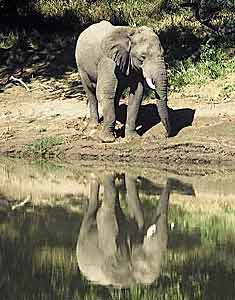Contact Details: Scotch Macaskill, Dirt Road Traders, Currys Post Road, Howick, KwaZulu-Natal, South Africa. Tel: +27 (0)82 578 2329. Privacy: Your privacy is guaranteed. See our Privacy Policy for more. This site accepts advertising and other forms of compensation - see Disclosure and Advertising for details. Site updated: 2022. Copyright © 2002 - 2022 Scotch Macaskill

| ||||||||||
|
||||||||||
|
SEE ALL
|
Social Behaviour and Communication in Elephants - 3Memory and RecognitionElephants living in big social organisations require good memory and recognition capabilities due to the fluid society in which they live. This is because they are constantly separating from the family unit and at the same time, meeting family and non-family members on a daily basis, so need to be able to recognise kin from non-kin; Carol Buckley witnessed two individuals that reunited after 23 years of being apart. (Granli et al 2006)
Fig 6. Elephant reflection Elephants have large brains and their cerebral cortex is highly developed which enables them to achieve a greater potential of learning and retaining this information for long periods of time. (Granli et al 2006) This gives the elephant a level of intelligence which other land mammals may not have. They are also able to see their reflection in the mirror, a skill that only humans and some primates are able to do. (See Fig 6) One important aspect of recognition and memory in elephants is to avoid inbreeding depression from occurring. Apparently, elephants are able to distinguish paternal kin from non-kin by phenotype matching using olfaction, but the mechanism is still unknown. The dispersal of one sex in elephants, usually males, is vital to prevent inbreeding depression in addition to their ability to recognise kin and avoid mating with them. (Moore, 2007) Elephants' efficient sense of smell is also used to allow them to make mental maps of their conspecifics' whereabouts and thus track the location of their family members simply by sniffing their urine. (McKenna, 2007) One study presented African elephants with urine samples that were either kin or unrelated individuals, situated in locations that were either unexpected or predictable. The elephants' behaviour and reactions to these cues illustrated that they could recognise up to 17 females and 30 family members. (Bates et al 2008) Not only do their senses provide the means for recognition and memory, but their family unit supplies the teaching blocks for young elephants. Calves watch their mothers and older sisters during their days in the bush and learn from them with regards to finding food and water i.e. using their trunk to dig into the ground to reach the water table. They also make note of how the adults react and behave towards different individuals and they retain this information as a guide during their adulthood. Most actions observed by elephants have been learned during childhood which illustrates their good memories. ConclusionOne can conclude therefore that elephants are extremely intelligent mammals due to their very advanced sensory systems and social structure. If elephants did not have such powerful sense of smell, touch and the like, their social organisation would not be as specialised as it is today with regards to communication and dispersal.It is also their ability to learn from interacting with individuals in their intricate social grouping and to recognise important cues for long periods of time which further adds to their intelligence and complex social network. About the Author: Rachael Adams wrote this paper on Elephant Communication as part of her Comparative Zoology course-work while a student at the University of Dundee, Scotland. It is published with her permission. ReferencesBooksKrebs, J. R., Davies, N. B. 1993. An Introduction to Behavioural Ecology - Third Edition. Blackwell Publishing. Oxford, UK. Wilson, E.O. 2000. Sociobiology - The New Synthesis. Twenty Fifth Anniversary Edition. The Belknap Press of Harvard University Press Cambridge, Massachusetts and London, England. Wyatt, T.D. 2003. Pheromones and Animal behaviour - Communication by Smell and Taste. Cambridge University Press. UK Journals
Leong, K.M., Ortolani, A., Graham, L.H., Savage, A. 2003. The Use of Low-Frequency Vocalisations in African Elephant (Loxodonta Africana) Reproductive Strategies. Journal of Hormones and Behaviour. Vol 43(4): 433-43. McComb, K., Moss, C., Sayialel, S., Baker, L. 2000. Unusually Extensive Networks of Vocal Recognition in African Elephants. Journal of Animal Behaviour. Vol 59: 1103-1109 McComb, K., Reby, D., Baker, L., Moss, C., Sayialel, S. 2003. Long-distance Communication of Acoustic Cues to Social Identity in African Elephants. Journal of Animal Behaviour. Vol 65: 317-329. Moore, J. 2007. Phenotype Matching and Inbreeding Avoidance in African Elephants. Journal of Molecular Ecology. Vol 16(21): 4421-4423. Rasmussen, L.E.L., Schulte, B.A. 1998. Chemical Signals in the Reproduction of Asian (Elephas maximus) and African (Loxodonta Africana) Elephants. Journal of Animal Reproduction Science. Vol 53: 19-34. Websites
Granli, P., Poole, J. 2006. Why and How Elephants Communicate - Elephant Voices. Available at: McKenna, P. 2007. Elephants Use Mental Maps to Track Family Members - New Scientist. Available at: McKenna, P. 2007. Elephants Can Sniff out Human Friends from Foe - New Scientist.
Journal of Current Biology. Available at: Photographs © Scotch Macaskill. Return to Wildlife Articles |
|||||||||
|
| ||||||||||